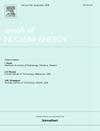ASTEC core degradation calculations in support of Level-2 Probabilistic Safety Assessment for 1300MWe French reactors: Methodology and preliminary results
IF 1.9
3区 工程技术
Q1 NUCLEAR SCIENCE & TECHNOLOGY
引用次数: 0
Abstract
The Institute for Radiation Protection and Nuclear Safety (IRSN) in France has updated its Level-2 Probabilistic Safety Assessment (L2 PSA) for the French 1300MWe Pressurized Water Reactors (PWRs) as part of the decennial safety reevaluation for these specific reactor units. This study was particularly underpinned by computations performed using the IRSN ASTEC V2.2 code. ASTEC, which stands for Accident Source Term Evaluation Code, is the reference integral code employed by IRSN for modeling and predicting the progression of severe accidental sequences. Within this framework, IRSN has conducted a total of 554 simulations of accidental sequences, for both conditions of 100% Nominal Power and of reactor shutdown. These accidental sequences have been defined based on the ASNR results of Level-1 PSA. They encompass the entire spectrum of events starting from initiating event to the point of vessel rupture. Furthermore, these simulations implement state-oriented Emergency Operating Procedures (EOPs) and Severe Accident Management Guidelines (SAMGs). This paper presents the different calculations carried out, outlines the methodology used to define them and the primary outcomes derived.
支持法国1300MWe反应堆2级概率安全评估的ASTEC堆芯退化计算:方法和初步结果
法国辐射防护与核安全研究所(IRSN)对法国 1300MWe 压水堆(PWR)的二级概率安全评估(L2 PSA)进行了更新,作为这些特定反应堆机组十年一次的安全再评估的一部分。这项研究尤其以使用 IRSN ASTEC V2.2 代码进行的计算为基础。ASTEC 是事故源项评估代码的缩写,是 IRSN 用于模拟和预测严重事故序列进展的参考积分代码。在此框架内,IRSN 对 100% 名义功率和反应堆停堆两种情况下的事故序列共进行了 554 次模拟。这些事故序列是根据一级 PSA 的 ASNR 结果定义的。它们涵盖了从起始事件到容器破裂点的所有事件。此外,这些模拟还实施了以状态为导向的紧急操作程序 (EOP) 和严重事故管理指南 (SAMG)。本文介绍了所进行的各种计算,概述了定义这些计算的方法以及得出的主要结果。
本文章由计算机程序翻译,如有差异,请以英文原文为准。
求助全文
约1分钟内获得全文
求助全文
来源期刊

Annals of Nuclear Energy
工程技术-核科学技术
CiteScore
4.30
自引率
21.10%
发文量
632
审稿时长
7.3 months
期刊介绍:
Annals of Nuclear Energy provides an international medium for the communication of original research, ideas and developments in all areas of the field of nuclear energy science and technology. Its scope embraces nuclear fuel reserves, fuel cycles and cost, materials, processing, system and component technology (fission only), design and optimization, direct conversion of nuclear energy sources, environmental control, reactor physics, heat transfer and fluid dynamics, structural analysis, fuel management, future developments, nuclear fuel and safety, nuclear aerosol, neutron physics, computer technology (both software and hardware), risk assessment, radioactive waste disposal and reactor thermal hydraulics. Papers submitted to Annals need to demonstrate a clear link to nuclear power generation/nuclear engineering. Papers which deal with pure nuclear physics, pure health physics, imaging, or attenuation and shielding properties of concretes and various geological materials are not within the scope of the journal. Also, papers that deal with policy or economics are not within the scope of the journal.
 求助内容:
求助内容: 应助结果提醒方式:
应助结果提醒方式:


